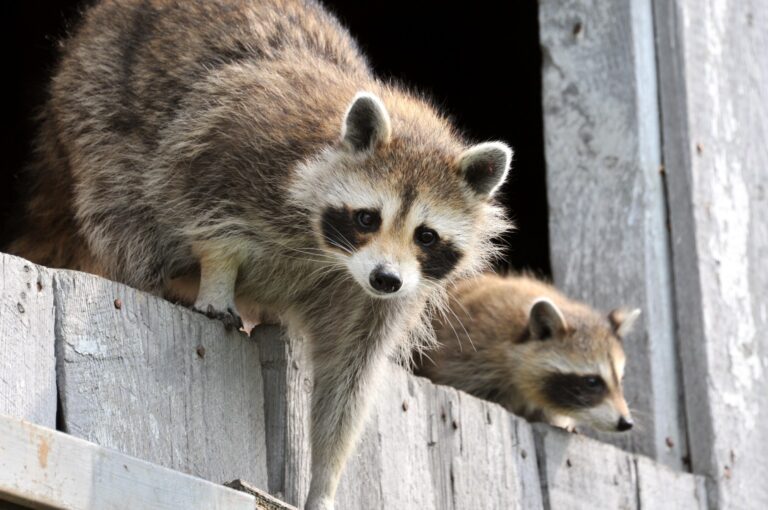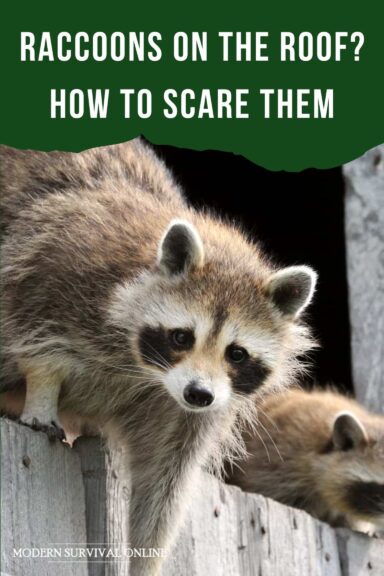Raccoons are definitely some of the coolest and most interesting animals out there, but only if they aren’t causing problems on your property.

They are relentless break-in artists when it comes to garbage cans, pet food, chicken coops, and more and if you get a large troop of them hanging around you’re bound to have issues. Those issues will turn into a legitimate nightmare if they get inside your attic or elsewhere in your home.
And when it comes to home invasion, raccoons typically find their way in off of the roof, sneaking in through soffits, attic vents, chimneys, and more. Accordingly, if you have one on your roof you need to get it down from there and scare it away, and hopefully not break your neck in the process.
To help you do that I’m bringing you a list of tips that will help you scare raccoons off of your roof easily, in addition to using baits and traps which I’ve already covered. Keep reading and we will get right to it…
Motion Lighting
It’s not unheard of to see a raccoon in the daytime, but they’re predominantly nocturnal. Being prey animals, being illuminated and exposed raises their levels of anxiety, and might cause them to retreat to cover wherever they are.
You can use this quirk of psychology against them by employing motion lighting around your home and, if necessary, up on your roof that will activate when raccoons come near. Lacking that, spotlight them with a powerful flashlight if you are out on “patrol.”
Loud, Sharp Sounds
Even though raccoons are often urbanized, a term meaning that they have learned to live near and alongside human habitation and activity, they’re still startled and unnerved by loud noises. Raise enough ruckus, and a raccoon might decide that discretion is the better part of valor and hit the trail.
To do this, you can yell, bang sticks or boards together, rattle a trash can lid, or use a pail full of gravel. Anything that will create a sharp, loud sound might be enough to spook them away.
Just pay attention, because if they duck inside your house, you’ll have to try a new tactic to get them out!
Garden Twirlers
Garden twirlers are those wind-powered decorations that take the form of pinwheels, spirals, or concentric rings of reflective discs.
Whatever they are and whatever they look like, if you get some that are a bright, shiny reflective metal you might be able to rely on them to keep raccoons and other mammals away.
There’s something about the glint and movement of these things that just unsettles most animals.
Being so unsure of what they are, most raccoons will choose to take their chances elsewhere. Hang these up strategically around your home and especially near the known approaches that raccoons use to scamper up to your roof. Hopefully it will deter them!
Mothballs
One of the oldest and best-known methods for deterring raccoons, mice, rats and other varmints is the use of mothballs. Chances are this is what your great-granddad did to keep pesky critters at bay, and if it’s good enough for him it’s good enough for us…
Mothballs have that strong, nose-stinging odor because of a compound called naphthalene. It’s deadly to moths, but merely a strong deterrent to animals with sensitive noses. Animals like raccoons!
All you need to do is place mothballs at strategic points around the foundation of your property, especially near spots where raccoons like to climb up to the roof.
Placing a few up at the roof line by tucking them under shingles is also a good idea, as is putting them inside the attic near vents and other potential entrances. They don’t last forever, and you’ll have to replace them occasionally (and sooner after it rains), but this is one of the cheapest and best options.
Epsom Salt
This is another one of my favorite and time-tested raccoon repellents, and one that I didn’t know about until just recently.
To us humans, Epsom salt doesn’t really have any odor at all, but for whatever reason the chemical composition of the stuff is intolerable to many mammals. I can guarantee you that raccoons positively hate it!
Even better, the smell seems to drift for quite a long distance, so putting rings of Epsom salt around your home and elsewhere on your property might keep raccoons off of your land entirely.
The best part is Epsom salt is cheap, freely available, and pretty friendly, environmentally speaking- though you don’t want it to get into the soil where you plan on growing anything!
Remember to refresh it periodically as it degrades and washes away.
Black or White Pepper
Raccoons, as mentioned, have incredibly sensitive noses. They are sensitive both in terms of overall efficiency at sniffing out food, mates, and threats, but also in their vulnerability to irritants.
Pepper is delicious on our own food, but if you’ve ever gotten a nose full of the stuff you know how unpleasant it can be! Imagine how much worse it’ll be for a raccoon.
Grind this stuff up fresh and then sprinkle it literally wherever you know raccoons go and move around.
Once they get a good snoutful of stuff it is going to send them into a coughing and sneezing fit, and after one or two close encounters they will probably associate your home and roof with pain, and leave you alone.
Red Pepper Flakes or Powder
Red pepper flakes work very much like black pepper and white pepper when it comes to repelling raccoons from your roof. Any raccoon that runs into the stuff and either tries a taste or gets a good whiff of it is going to be in for a searing surprise.
Even though the compound contained in red pepper flakes, and all other spicy peppers, causes mammals significant pain when it comes into contact with skin, mucous membranes, taste buds, or eyes, it isn’t overtly harmful.
This is really going to knock any trespassing raccoon for a loop, but it will leave them no worse for the wear after the effects subside in half an hour or so.
Best of all, this is another extremely cheap and environmentally friendly option: you won’t have to worry about this hurting the environment, your land, or any materials on your home. Just don’t get it in your own eyes!
Cinnamon
Another raccoon repellent that you’ve probably got in your own pantry right now. Sure, it makes our desserts taste wonderful, but this stuff is ferociously irritating to many mammals. Indeed, that flavor we love so much is actually a defense mechanism developed by the plant to prevent it from being eaten!
You probably don’t need me to tell you how to use cinnamon at this point: scatter it liberally anywhere that you know the raccoons will go and be sure to coat all of their approaches and climbing points that they use to get up on your roof.
Grab yourself a big economy jug if you want to, and don’t hesitate to lay a thick perimeter around the edge of your roof so the raccoons will run into it nose-first as they climb.
Predator Scent
Raccoons might be notorious predators of chicken and duck coops, but they themselves are prey for larger and more capable animals like wolves, coyotes, bobcats, and more.
Accordingly, they are always alert to any indication that a predator might be nearby, and the number one tool they use to figure that out is their nose.
If a raccoon can physically smell the predator, or even evidence of their passage in the form of urine or droppings, they will be a lot more fearful and more prone to head the other way.
Exploit this predator nervousness by acquiring predator scent from a hunting supply retailer or a pest control outlet.
Note that this stuff can be pretty stinky, obviously, and you probably don’t want to smell it yourself but it works wonderfully for repelling raccoons especially if they are already setting up a nest inside your home.
Boar Raccoon Scent
Most mommy raccoons that are looking for a safe place to nest, like inside your attic for instance, will avoid male, or boar, raccoons because they have a tendency to kill little babies.
Just like we used predator scent above, you can acquire specialty male raccoon scent and use it to scare off any adventurous, exploring females and younger, nervous males from your property and roof.
As usual, spray liberally and reapply often as it wears out. Once you know the raccoons are long gone, you can stop.


Like what you read?
Then you're gonna love my free PDF, 20 common survival items, 20 uncommon survival uses for each. That's 400 total uses for these dirt-cheap little items!
We will not spam you.